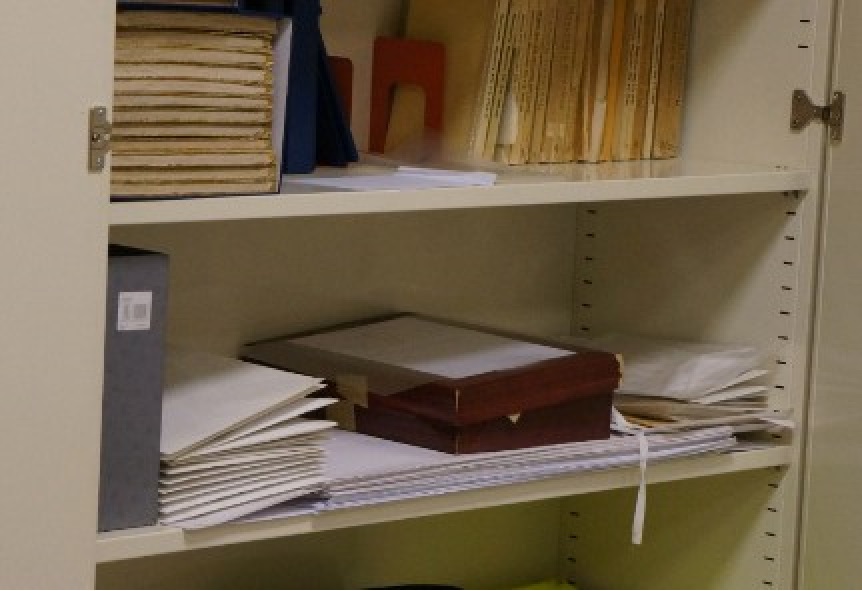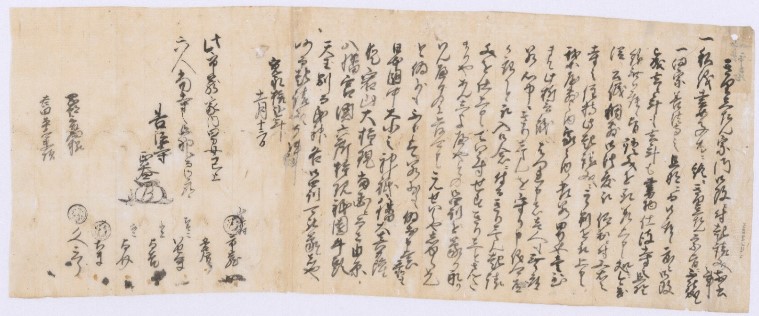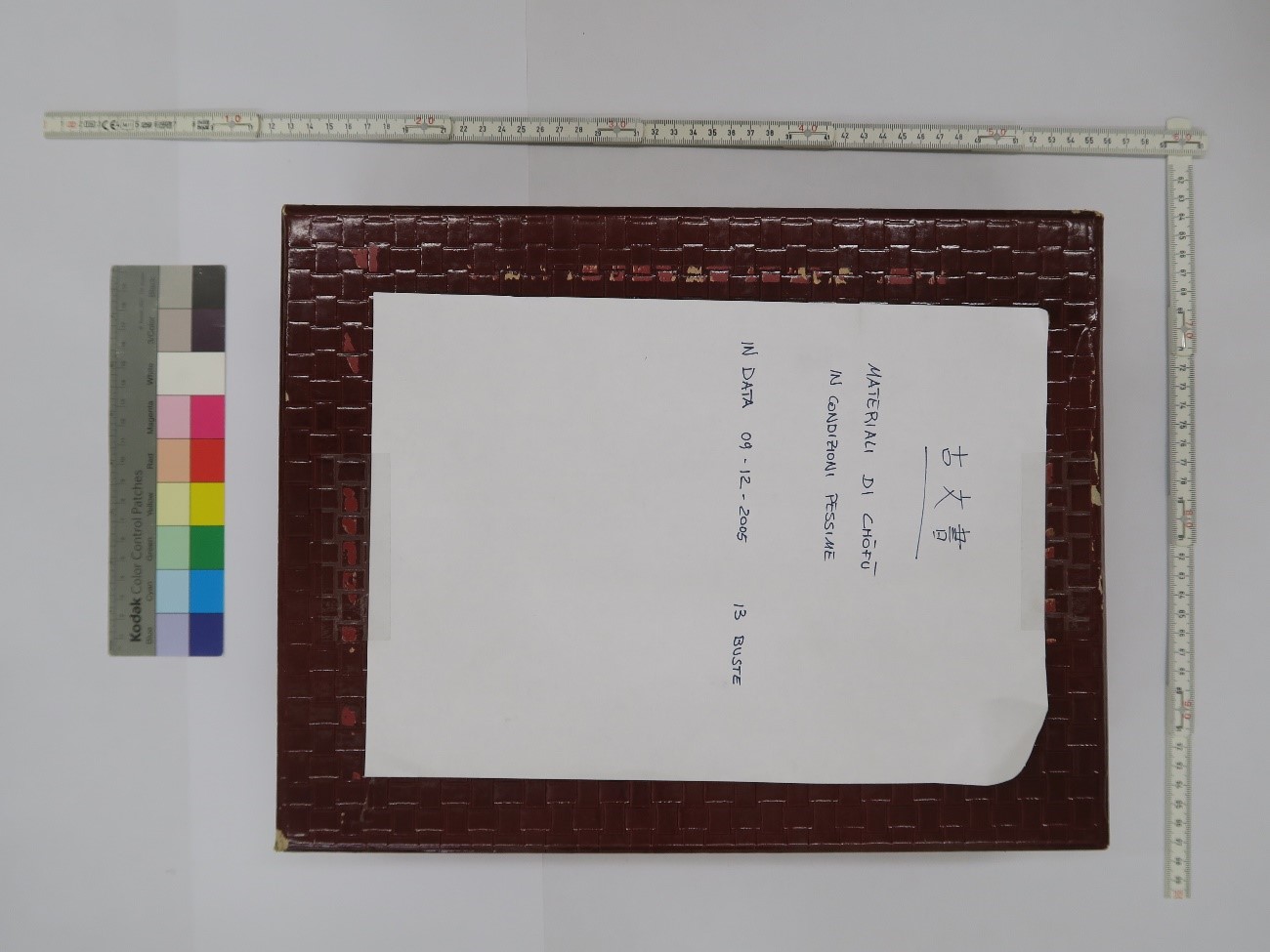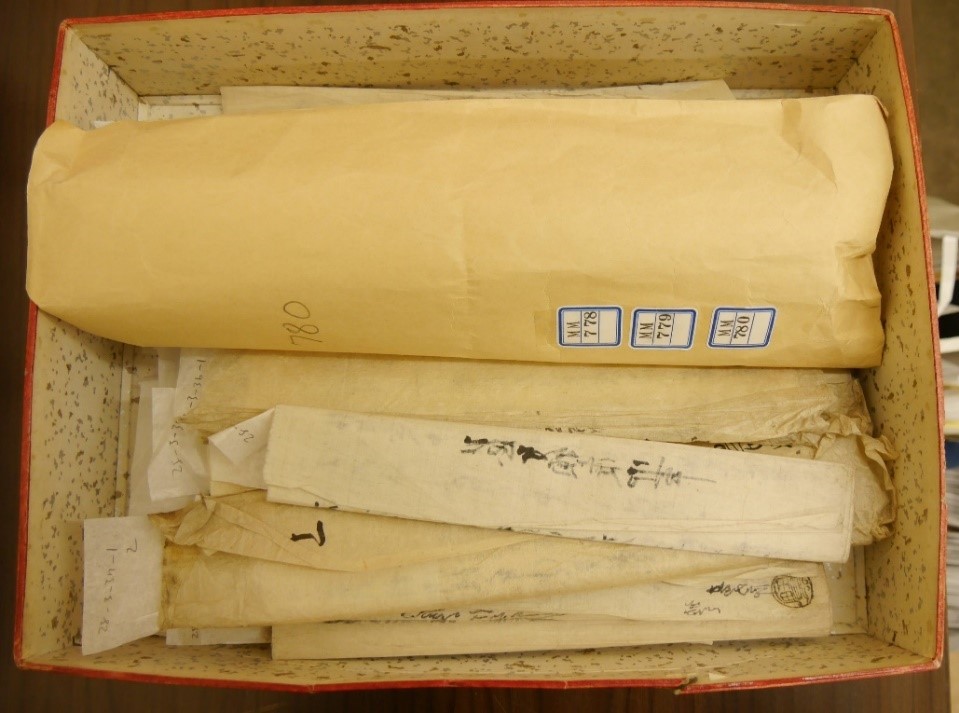- Reference Code
maregaA24
- Title
Fonds Marega File A24
- Date Range
- 1624–1879 (excluding non-dated documents, overview memos, newspapers, etc.)
- Primary Date Range
- There are 198 documents that have dates. 24 are from the Kanbun era (1661-1673) and 49 are from the Enpō era (1673–1680).
- Date Range Notes
- 1635 (Kan’ei 12) to 1879 (Meiji 12)/dd>
- Description Level
File
- Quantity
- 396 records (311 jō 状, 3 tsuzuri 綴, 8 tatechō 竪帳, 8 yokochō 横帳, 26 hōshi 包紙, 27 paper slips, 1 newspaper, 8 envelopes, 1 bag, 2 koyori 紙縒, 1 manuscript)
- Notes on Physical State
- These materials have been passed down as part of the Marega Collection held by the Salesian Pontifical University’s library (Rome). At the time of the February 2016 library survey, they were part of its Marega Archives. Some documents were stored between thick sheets of paper and assigned numbers. Their numbers spanned from 1 to 43. However, documents corresponding to numbers 21 and 30 were not found. While the documents that followed 1 to 43 were stored in groups (square envelopes of the Ōita Prefectural Library, organizational envelopes of the Ōita Prefecture Ancient Sages Historical Archives, etc.), numbers were not assigned to them. No catalogue had been created. Overall this file was badly damaged. Also, what was originally a single document had been treated as two documents because parts held together with glue had become detached. Taking into account the state of these materials, they were moved to the Vatican Library without any changes being made.
- Provenance / Creation
- Father Mario Marega. Originally from the Usuki Domain Office of Religious Affairs (Shūmonkata 宗門方), the Okuyama family of Izumita Village (Mogami District, Dewa Province) (details unclear), and elsewhere.
- Place Name
- Usuki City and Ōita City (Ōita Prefecture), Chōfu City (Tōkyō-to), Himon’ya (Meguro City, Tōkyō-to)
- Positions, etc
- Salesians of Don Bosco missionary.
- Archival History
- A24 is held by the Salesian Pontifical University’s Library and is managed by the Vatican (as of 2020). In the early 1980s, during a survey of the Chofu (Tokyo) Salesian Seminary carried out by the late Salesian Father Mizobe Osamu and the late Akamine Shigenobu (Oita Prefectural Library), this group of documents was discovered in a cardboard box on a top shelf in the dining hall. It was then stored in a cabinet at the seminary. In 2011, part of it was displayed for an autumn exhibition about Bungo Christian history held at the Oita Prefecture Ancient Stages Historical Archives. Around 2005, Father Mizobe sent it to the university’s library in Rome. Some of Marega’s documents being held at the seminary appear to be connected to Father Marega having worked as a teacher there in 1950 and at the Salesians’ Junior College (Sarejio Tanki Daigaku) in the following year. In 1953, Father Marega donated to the Vatican almost all of the documents he collected in Oita Prefecture. It appears that A24 was not included because it was stored separately (at the seminary). The documents sent to the Salesian Pontifical University’s Library (A24) were stored in a cabinet as part of the Marega Collection. Many are in very poor condition and no library intake catalogue has been created. In May 2016, these documents were received by the Vatican for repairs, etc.
- Acquisition Source
- Father Marega. Many of the documents Marega collected were originally from the Usuki Domain's Office of Religious Affairs (Shūmonkata 宗門方). There are documents from other places, such as the Okuyama family of Izumita Village (Mogami District, Dewa Province) and the Kiji-Munechika Unit of Kitsuki Domain. These were probably purchased by Father Marega at antiquarian bookshops and the like.
- Scope and Content
The survey at the Vatican Library was carried while taking into account the state the materials were found in at Salesian Pontifical University’s Library. As is written under “Notes on Physical State,” the documents corresponding to numbers 21 and 30 could not be identified. Therefore, A24.21 and A24.30 are unassigned numbers. Most of A24 is originally from the Usuki Domain's Office of Religious Affairs. There were 158 documents with Father Marega's organizational numbers, etc. There are 198 documents that can be dated. The oldest are from 1635 (Kan’ei 12) (5 documents). “Kirishitan shūmon oaratame ni tsuki gokishōmon maegaki no koto” きりしたん宗門御改ニ付御起請文前書之事 (“Religious investigation pledges,” A24.4) is a document created about Yamaoku Village's Ichizō family, its servants, and its low-class farmers. The individuals written therein are parishioners of Zenbōji temple. They have pledged to Japan's gods, Zeus, Christ, and others that they will not become Christian and signed in blood. Zenbōji temple has attested to this with a signature and seal. This oath combines an oath to Japan's gods (Nihon seishi 日本誓詞) and an oath to foreign gods (nanban seishi 南蛮誓詞).
In the oath “Kirishitan shūmon o aratame ni tsuki kishōjō no koto” きりしたん宗門御改ニ付御請状之事 (A24.3), the priest Takuzō-bō, who lives in Nazuka Village, attests that no one living at his temple is Christian. Based on these documents, the Usuki Domain had village units create “Kirishitan shūmon no oaratame no ochō” きりしたん宗門御改之御帳The A24.2.1 “Kirishitan shūmon no oaratame no ochō” covers 526 men and women from the Shibao Village Unit and includes 72 oaths. The listed total number of men is 269, five of who are former Christians. The listed total number women is 257, five of who are former Christians. We can see that there was a total of ten former Christians in the Shibao Village Unit. In this way, this document provides us a glimpse into Christianity prohibition regime policy in Usuki Domain at the beginning of the early modern period.
There are many documents from the late seventeenth century. There are 48 notifications from parishioner temples to religion magistrates (shūmon bugyō 宗門奉行) regarding parishioner temple changes resulting from marriages, adoptions, etc. that took place between 1672 (Kanbun 12) and 1676 (Enpō 4). One also finds a reply (A24.7) regarding a report to the Nagasaki Governor (bugyō 奉行) Kawaguchi Munetsune (who was in Edo) that the wife of Mori Village’s Gozaemon died while imprisoned after being apprehended in the exposure and mass arrest of Christians that is referred to as the Bungo Kuzure. It appears that this reply is from the twenty-sixth day of the second month of 1691 (Genroku 4) (A24.7).
Also, there are documents, although few, in A24 that are not from the Usuki Domain’s Office of Religious Affairs. With regard to the Bungo Province, for example, A24.57.2 and A24.60 to A24.67 are related to the services of the domain’s office and Tonoue family’s household accounts in the Meiji period. In addition, the documents of A24.55.22 and A24.76.1 to A24.76.13 are related to the Kiji-Munechika Unit of Kitsuki Domain. As to the outside of the province, the fifty-two documents spanning from A24.72.2.1 to A24.72.3.37 appear to be related to the Izumita Village’s Okumura Jinbē family (Mogami District, Dewa Province). Also, A24.72.1.1 and A24.72.1.2 are related to Wataya Tokuemon, the town representative of Mentai (Ōsaka Minamigumi). A24.84.1 to A24.84.5 are related to Koshigoe Village in Age District, Suruga Province. There were also a few survey / research notes written by Father Marega.
Names of Holding Institutions: Salesian Pontifical University’s Library (managed by the Vatican Library as of 2020)- Languages Used
- (Approximate) Japanese - 375, Italian - 19, English - 2
- Date Description Written
- 2019/09/30
- Reference Images





